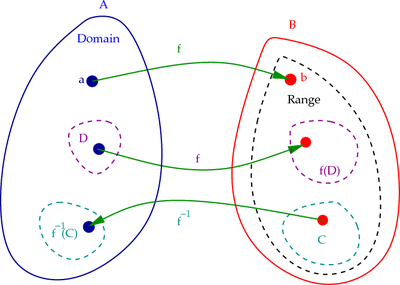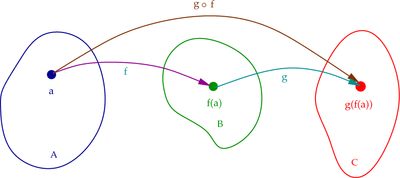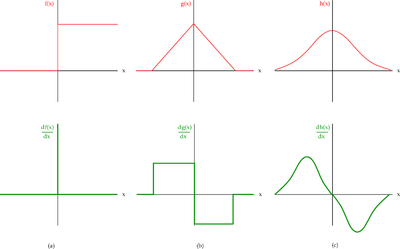Continuum mechanics/Functions
< Continuum mechanics-- Back to Nonlinear finite elements --
There are certain terms involving relationships between functions that you will often encounter in papers dealing with finite elements and continuum mechanics. We list some of the basic terms that you will see. More details can be found in books on advanced calculus and functional analysis.
Functions
Let  and
and  be two sets. A function is a rule that assigns to
each
be two sets. A function is a rule that assigns to
each  an element of
an element of  . A function is usually denoted by
. A function is usually denoted by
Sometimes, one also writes
For example, if the function is  , then we may write
, then we may write
 .
.
Domain and Range
For a function  , the set
, the set  is called the
domain of
is called the
domain of  . See Figure 1.
. See Figure 1.
 Figure 1. Domain and range of a function. |
The range of  is the set
is the set
Therefore,  .
.
One-to-one mapping (injection)
A function  is called one-to-one
(or an injection) if no two distinct elements of
is called one-to-one
(or an injection) if no two distinct elements of  are mapped to
the same element of
are mapped to
the same element of  .
.
Onto mapping (surjection)
A function  is called onto if for every
is called onto if for every
 there is an
there is an  such that
such that  .
.
If that case,  .
.
One-to-one and onto mapping (bijection)
When a mapping is both one-to-one and onto it is called a bijection.
For example, if  and
and  with
with
the map is one-to-one and onto.
On the other hand if
the map is one-to-one but not onto.
If we choose
the map is neither one-to-one nor onto.
Image, pre-image, and inverse functions
Suppose we have a function  . Let
. Let  be a subset
of
be a subset
of  (see Figure~1). Let us define
(see Figure~1). Let us define
Then,  is called the image of
is called the image of  .
.
On the other hand, if  is a subset of
is a subset of  and we define
and we define
Then,  is called the inverse image or pre-image
of
is called the inverse image or pre-image
of  .
.
If  is one-to-one and onto, then there is a
unique function
is one-to-one and onto, then there is a
unique function  such that
such that
The function  is called an inverse function of
is called an inverse function of  .
.
Identity map
The map  such that
such that  for all
for all  is called
the identity map. This map is one-to-one and onto.
is called
the identity map. This map is one-to-one and onto.
Composition
A notation that you will commonly see in papers on nonlinear solid mechanics is the composition of two functions. See Figure 2.
 Figure 2. Composition of functions. |
Let  and
and  be two functions such that
be two functions such that  and
and
 . The composition
. The composition  is
defined as
is
defined as
Let us consider a stretch ( ) followed by a translation (
) followed by a translation ( ). Then
we can write
). Then
we can write  and
and  .
.
The composition  is given by
is given by
The inverse composition  is given by
is given by
Isomorphism and Homeomorphism
You will also come across the terms isomorphism and homeomorphism in the literature on nonlinear solid mechanics.
Isomorphism is a very general concept that appears in several areas of mathematics. The word means, roughly, "equal shapes". It usually refers to one-to-one and onto maps that preserve relations among elements.
A homeomorphism is a continuous transformation between two geometric figures that is continuous in both directions. The map has to be one-to-one to be homeomorphic. It also has to satisfy the requirements on an equivalence relation.
Continuously differentiable functions
A function
is said to be  -times continuous differentiable or of class
-times continuous differentiable or of class
 if its derivatives of order
if its derivatives of order  (where
(where  ) exist and are
continuous functions.
) exist and are
continuous functions.
Figure 3 shows three functions ( ,
,  ,
,  )
and their derivatives.
)
and their derivatives.
 Figure 3: Continuity of functions. |
 Functions
Functions
The function  is called the Heaviside step function (usually
written
is called the Heaviside step function (usually
written  ) which is defined as
) which is defined as
The derivative of the Heaviside function is the Dirac delta function
(written  ) which has the defining property that
) which has the defining property that
for any function  and any constant
and any constant  . The delta function is
singular and discontinuous. Hence, the Heaviside function is not
continuously differentiable. Sometimes the Heaviside function is said to
belong to the class of
. The delta function is
singular and discontinuous. Hence, the Heaviside function is not
continuously differentiable. Sometimes the Heaviside function is said to
belong to the class of  functions.
functions.
 Functions
Functions
The function  in Figure 3 (also called a hat
function) is continuous but has discontinuous derivatives. In this
particular case, the function has the form
in Figure 3 (also called a hat
function) is continuous but has discontinuous derivatives. In this
particular case, the function has the form
Such functions that are differentiable only once are called  functions.
functions.
 Functions
Functions
The function  in Figure 3 is infinitely
differentiable and has continuous derivatives every time it is differentiable.
Such functions are called
in Figure 3 is infinitely
differentiable and has continuous derivatives every time it is differentiable.
Such functions are called  functions. Since the function can
be differentiated once to give a continuous derivative, it also falls into
the category of
functions. Since the function can
be differentiated once to give a continuous derivative, it also falls into
the category of  functions.
functions.
Sobolev spaces of functions
You will find Sobolev spaces being mentioned when you read the finite element literature. A clear understanding of these function spaces needs a knowledge of functional analysis. The book Introduction to Functional Analysis with Applications to Boundary Value Problems and Finite Elements by B. Daya Reddy is a good starting point that is just right for engineers. We will not get into the details here.
Of particular interest in finite element analysis are Sobolev spaces of functions such as
where
The function space  is the space of square integrable
functions.
is the space of square integrable
functions.
Of interest to us is an outcome of Sobolev's theorem which says that
if a function is of class  then it is actually a bounded
then it is actually a bounded
 function. If we choose our basis functions from the set of square
integrable functions with continuous derivatives, certain singularities
are automatically precluded.
function. If we choose our basis functions from the set of square
integrable functions with continuous derivatives, certain singularities
are automatically precluded.

















